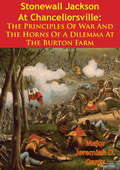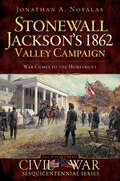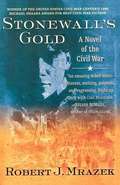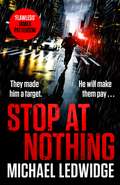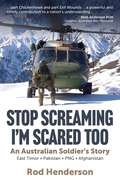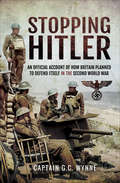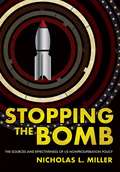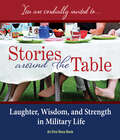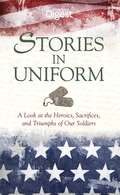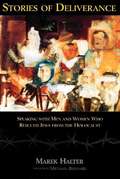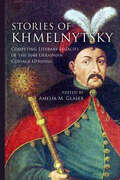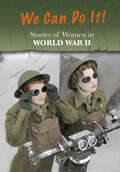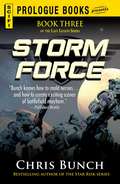- Table View
- List View
Stonehenge
by Bernard CornwellBestselling author Bernard Cornwell takes us back four thousand years, to a vibrant world of ritual and sacrifice that is at once timeless and wholly original. This historical novel unlocks the mystery of Britain's most haunting and puzzling structure, and tells a tale of three brothers--fierce rivals--who are uneasily united in their quest to create a temple to their gods. Lengar, the eldest brother, kills his own father to become chief of his tribe. Camaban, the illegitimate middle brother, is determined to have a massive temple built in his own honor. And Saban, the youngest, who actually builds Stonehenge, must act as mediator between the other two. Stonehenge is the enthrallingly dramatic story of patricide, betrayal, and murder; of bloody brotherly rivalry; and of the never-ending quest for power, wealth, and spiritual fulfillment.
Stones for My Father
by Trilby KentCorlie Roux's farm life in South Africa is not easy: the Transvaal is beautiful, but it is also a harsh place where the heat can be so intense that the very raindrops sizzle. When her beloved father dies, she is left with a mother who is as devoted to her sons as she is cruel to her daughter. Despite this, Corlie finds solace in her friend, Sipho, and in Africa itself and in the stories she conjures for her brothers.But Corlie's world is about to vanish: the British are invading and driving Boer families like hers from their farms. Some escape into the bush to fight the enemy. The unlucky ones are rounded up and sent to internment camps.Will Corlie's resilience and devotion to her country sustain her through the suffering and squalor she finds in the camp at Kroonstad? That may depend on a soldier from faraway Canada and on inner resources Corlie never dreamed she had....From the Hardcover edition.rlie is strong and can draw on her knowledge of the land she loves, but is that enough to help her survive the starvation, disease, and loss that befalls her in the camp?From the Hardcover edition.
Stones in Water
by Donna Jo NapoliSet in World War II, a young Italian boy and his friends were taken by the Germans and put in labor camps. This is the story of how they endured beatings, starvation, and freezing temperatures, and how some of them survived.
Stones of Jerusalem: The Zion Legacy
by Brock Thoene BodieThe Old City has fallen and Moshe Sachar, the courageous Israeli leader, remains hidden in an underground tunnel, guarding the ancient sacred scrolls that tell of his people's long, heroic history. Following an elder rabbi's instructions, Moshe opens a scroll and again becomes immersed in the ancient biblical tale of Marcus, the Roman centurion, and Miryam, the troubled young woman he loves.
Stonewall Jackson At Chancellorsville: The Principles Of War And The Horns Of A Dilemma At The Burton Farm
by Major Jeremiah D. CantyThe Battle of Chancellorsville in May 1863 and particularly the Flank March and Attack under Jackson served as a metaphor for the operational victories the South gained while at the same time signifying why the South could not hope to win strategically based on a policy of accepting greater levels of risk than its Northern opponent.In the spring of 1863 the Federal cause had just recovered from the disasters of the previous year with a resurgent army and leadership...General Hooker headed south to try his hand against the nemeses of the North; General Lee and General Jackson. Initially, Hooker was very successful and essentially "turned" Lee's position at Fredericksburg...Lee, facing defeat in detail as he attempted to hold off two possible Federal thrusts, was galvanized into action that seemed to defy the military principles of the day. Dividing his already heavily outnumbered army Lee attacked the eastern most elements of Hooker's army that was south of the river. The unexpected thrust unnerved Hooker who withdrew back into the Wilderness to fall back on defensive positions in anticipation of further Confederate attacks. Lee and Jackson realized they had no choice but to attack the Federals and decided on yet another division of the army, in further defiance the principles of war. Even though Hooker correctly appreciated Lee's intent he failed to take adequate precautions against a Confederate move from the west. In spite of being observed on several occasions the Second Corps of "Stonewall" Jackson arrived on the flank of the Federal army and delivered one of the most crushing blows of the war. Lee and Jackson's ability to absorb levels of risk that were not feasible for Hooker to accept gave them a distinct advantage over the Federal commander and thus acted as a significant force multiplier.
Stonewall Jackson's 1862 Valley Campaign: War Comes to the Homefront (Civil War Sesquicentennial Series)
by Jonathan A NoyalasVirginia's Shenandoah Valley was known as the "Breadbasket of the Confederacy" due to its ample harvests and transportation centers, its role as an avenue of invasion into the North and its capacity to serve as a diversionary theater of war. The region became a magnet for both Union and Confederate armies during the Civil War, and nearly half of the thirteen major battles fought in the valley occurred as part of General Thomas J. "Stonewall" Jackson's 1862 Valley Campaign. Civil War historian Jonathan A. Noyalas examines Jackson's Valley Campaign and how those victories brought hope to an infant Confederate nation, transformed the lives of the Shenandoah Valley's civilians and emerged as Stonewall Jackson's defining moment.
Stonewall Jackson: Loved in the South; Admired in the North
by Charles LudwigA biography of the Confederate general who gained the nickname Stonewall for his stand at the first batle of Bull Run during the Civil War.
Stonewall's Gold: A Novel
by Robert J. MrazekA ripping adventure yarn, a moving coming-of-age tale, and a fascinating portrait of the difficulty of life in the Appalachians at the end of the Civil War, Stonewall's Gold is a compelling novel that is certain to appeal to teacher and student alike.
Stonewall's Prussian Mapmaker
by Robert K. Krick Richard Brady WilliamsPrussian-born cartographer Oscar Hinrichs was a key member of Stonewall Jackson's staff, collaborated on maps with Jedediah Hotchkiss, and worked alongside such prominent Confederate leaders as Joe Johnston, Richard H. Anderson, and Jubal Early. After being smuggled along the Rebel Secret Line in southern Maryland by John Surratt Sr., his wife Mary, and other Confederate sympathizers, Hinrichs saw action in key campaigns from the Shenandoah Valley and Antietam to Gettysburg, Petersburg, and Appomattox. After the Confederate surrender, Hinrichs was arrested alongside his friend Henry Kyd Douglas and imprisoned under suspicion of having played a role in the Booth conspiracy, though the charges were later dropped.Hinrichs's detailed wartime journals, published here for the first time, shed new light on mapmaking as a tool of war, illuminate Stonewall Jackson's notoriously superior strategic and tactical use of terrain, and offer unique perspectives on the lives of common soldiers, staff officers, and commanders in Lee's army. Impressively comprehensive, Hinrichs's writings constitute a valuable and revelatory primary source from the Civil War era.
Stop At Nothing: the explosive new thriller James Patterson calls 'flawless'
by Michael LedwidgeTHEY MADE HIM A TARGET. HE'LL MAKE THEM PAY.'FLAWLESS...Michael Ledwidge has the gift.' James Patterson, world's bestselling author.When a private jet crashes into the Caribbean sea, diving instructor Michael Gannon is the only person on the scene. Finding six dead men and a suitcase full of cash and diamonds, Gannon assumes he's the beneficiary of a drug deal gone wrong.However, it seems one of the passengers was the Director of the FBI - despite the official story that he died of natural causes in Italy. Suddenly pursued by a shadowy cabal of the world's most powerful and dangerous men, Gannon will only survive if he unravels a terrifying conspiracy.But those determined to kill him will learn that Gannon's past holds its own deadly secrets...and the hunters soon become the prey.One man will stop at nothing to survive in this pulse-racing thriller that will grip fans of Lee Child, David Baldacci, James Patterson and Gregg Hurwitz.(P)2020 HarperAudio
Stop At Nothing: the explosive new thriller James Patterson calls 'flawless' (Michael Gannon Ser. #1)
by Michael LedwidgeTHEY MADE HIM A TARGET. HE'LL MAKE THEM PAY.'The writing is sharp and the action doesn't let up. Stop at Nothing is flawless.' JAMES PATTERSON, world's bestselling author.'A gloriously pulpy, no-nonsense adventure...Ledwidge knows how to keep readers' adrenaline pumping.' THE TIMES When a private jet crashes into the Caribbean sea, diving instructor Michael Gannon is the only person on the scene. Finding six dead men and a suitcase full of cash and diamonds, Gannon assumes he's the beneficiary of a drug deal gone wrong.However, it seems one of the passengers was the Director of the FBI - despite the official story that he died of natural causes in Italy. Suddenly pursued by a shadowy cabal of the world's most powerful and dangerous men, Gannon will only survive if he unravels a terrifying conspiracy.But those determined to kill him will learn that Gannon's past holds its own deadly secrets...and the hunters soon become the prey.From the number one bestselling co-author of James Patterson's Michael Bennett series, this pulse-racing and page-turning thriller will grip fans of Lee Child, David Baldacci and Gregg Hurwitz.Why readers can't put this book down:'Michael Ledwidge is a pro at writing pacey, in-the-moment prose...I was HOOKED.' ***** Goodreads review'You will be on the edge of your seat flipping pages as fast you can.' ***** Goodreads review'A non-stop adventure guaranteed to entertain.' ***** Goodreads review
Stop Screaming, I'm Scared Too: An Australian soldier's story
by Rod HendersonThis book is part Chickenhawk and part Exit Wounds … a powerful and timely contribution to a nation&’s understanding of what we ask of our service men and women and the debt we owe … Matt Anderson PSM, Director, Australian War Memorial&‘Stop screaming, I&’m scared too!&’ is not what you&’d expect to see on the back of a loadmaster&’s helmet in a Chinook helicopter flying over southern Afghanistan, but for Rod Henderson it sums up his 22 years of service as a soldier in the Australian Army. During the busiest period in the Army&’s history, Rod was deployed to East Timor, Papua New Guinea, Pakistan and Afghanistan. In Australia, he was involved in counter terrorism operations and disaster recovery. From an infantry paratrooper, to Chinook loadmaster and Black Hawk door gunner, Rod reveals an enthralling and unique perspective of service. Whether it is &‘right place wrong time&’ or just unlucky, he found himself in a series of life threatening and traumatic events. Each one took a toll. Accepting the physical injuries and mental health challenges from his service, Rod found healing in the hallowed halls of the Australian War Memorial. This is not the story of a general or a Special Forces hero. It is the extraordinary memoir of a regular Australian soldier. Like so many others who have served their country with honour and distinction, the little-known stories of ordinary soldiers deserve to be told. In Stop Screaming, I&’m Scared Too, Rod reveals the depth of his soldiering experiences with humour, humility, self-reflection and honesty. Testimonials: "A gripping tale of duty, danger, and unexpected twists. This is the life of an infantry soldier turned door gunner on a chinook as a loadmaster in Afghanistan. What a ride" – Phillip Thompson OAM MP, Federal Member for Herbert &#
Stop at a Winner
by R. F. DelderfieldA humorous tale of the Pascoe family's tribulations and Pedlar Padcoe's journey in to the midst of the action of World War Two.
Stopping Hitler: An Official Account of How Britain Planned to Defend Itself in the Second World War
by Captain G.C. Wynne&“[A] unique account of British threat responses to potential German conflict . . . Strongly recommended&” (Firetrench). In the immediate aftermath of the First World War, it was expected that international disputes could be settled by arbitration through the creation of the League of Nations. Consequently, the British government concluded that there would not be another war in the foreseeable future and therefore the country&’s armed forces could be correspondingly scaled back. The rise of Nazism in Germany in the 1930s, however, prompted politicians and military leaders to contemplate the frightening prospect of another global conflict. The Chiefs of Staff of the three services were instructed to bring Britain&’s armed forces up to a standard where they could resist a revitalized and powerful aggressor, and to put in place plans for the defense of the country. When that war became a reality, the Chiefs of Staff then had to devise schemes to prevent a German invasion and, as the war progressed, to counter the bombers of the Luftwaffe and the flying bombs and rockets that followed. Reproduced here in its entirety is an official account drawn up by Capt. G. C. Wynne of the Historical Section, Cabinet Office in 1948. Arranged in four parts, corresponding to the four different threats that developed with the changing situations of the war, it details the various plans made for home defense between 1939 and 1945. &“A detailed study of the preparations and actual measures taken to prevent invasion during the Second World War.&” —Britain at War
Stopping the Bomb: The Sources and Effectiveness of US Nonproliferation Policy (Cornell Studies in Security Affairs)
by Nicholas L. MillerStopping the Bomb examines the historical development and effectiveness of American efforts to prevent the spread of nuclear weapons. Nicholas L. Miller offers here a novel theory that argues changes in American nonproliferation policy are the keys to understanding the nuclear landscape from the 1960s onward. The Chinese and Indian nuclear tests in the 1960s and 1970s forced the US government, Miller contends, to pay new and considerable attention to the idea of nonproliferation and to reexamine its foreign policies. Stopping the Bomb explores the role of the United States in combating the spread of nuclear weapons, an area often ignored to date. He explains why these changes occurred and how effective US policies have been in preventing countries from seeking and acquiring nuclear weapons. Miller's findings highlight the relatively rapid move from a permissive approach toward allies acquiring nuclear weapons to a more universal nonproliferation policy no matter whether friend or foe. Four in-depth case studies of US nonproliferation policy—toward Taiwan, Pakistan, Iran, and France—elucidate how the United States can compel countries to reverse ongoing nuclear weapons programs. Miller's findings in Stopping the Bomb have important implications for the continued study of nuclear proliferation, US nonproliferation policy, and beyond.
Stories Around the Table: Laughter, Wisdom, And Strength In Military Life
by Terri Barnes“Opening it up to any random story will make you feel humbled, grateful, and best of all, not alone.” —Anette Radonski, Military Spouse JD Network Conversations are the heart of a gathering among friends. In Stories Around the Table: Laughter, Wisdom, and Strength in Military Life, military spouses, parents, children, and service members gather together to laugh, cry, lend perspective, and share personal stories from their military life experience. From poignant to practical, tragic to humorous, these candid conversations from friends old and new shed heartfelt insight on many aspects of military life: ~ friendship, depression, romance in military marriage, caring for children with special needs in a mobile lifestyle, renewing relationships after deployment, career challenges for spouses, changing schools, post-traumatic stress, faith, grief, and so much more ~ “…will touch your heart.” —Phil Paleologos, WBSM “Awesome…like being with friends.” —Leon Francis, KFYR “…you will find yourself laughing, remembering, or grabbing a tissue and pausing to reflect on something that grabs at your heart and won’t let go…” —Kathleen M. Rodgers, Military Spouse Book Review “Marvelous…really important book.” —Frank Gaffney, Secure Freedom Radio “You will derive strength from it.” —Jim Bohannon, The Jim Bohannon Show Foreword Reviews INDIEFAB Book of the Year Awards – Silver Midwest Book Awards – Finalist
Stories from the Crusades
by Janet KelmanOnce upon a time there was an ugly little boy called Peter, who lived in his father's castle in France. He was a restless boy, and liked always to do or to hear something new. His home was very quiet, for his father was a great fighter, and was often away at the wars for months at a time.
Stories in Uniform
by Editors of Reader's DigestStories in Uniform is a chronological retrospective of the best military pieces Reader's Digest has run; pieces that will make you weep, make your heart sing, inspire you, enrage you, and make you laugh. Beginning in World War I and continuing though to the war in Iraq, readers will follow soldiers into the trenches, peer in on emergency surgery taking place in the depths of the ocean, watch heroes carry the bodies of fallen brethren, trail Eisenhower for the three days leading up to D-Day, and be inspired as men and women rise above and beyond normal human limits to preserve our rights and save their friends.Stories include:* A moving memorial to D-Day* A tribute to one of the first African-Americans to serve as a Naval Officer* A pilot rescued after his F-16 is shot down* A soldier returns to the front after losing his foot in action* An American soldier who takes a big risk to save a dying Afghan girlThis book gives a complete perspective on the hell that is war, the love that grows from camaraderie, the pride from accomplishing the impossible, the humor that springs from the military bureaucracy, and more.
Stories of Deliverance: Speaking with Men and Women Who Rescued Jews from the Holocaust
by Marek Halter Michael BernardWhen Marek Halter was five years old, he and his family fled from the Warsaw Ghetto with the help of two Polish Catholics. Fifty-three years later, now a distinguished French writer and social commentator, Halter returned to Warsaw, and from there went on a quest across Europe, seeking out and interviewing gentiles who had risked their own lives to save the lives of Jews in Nazi-occupied Europe." "From his research with Holocaust survivors, Halter developed a list of "the Just" - those who, according to Jewish tradition, must exist in each generation in order to save the world from destruction. Halter's encounters with these heroes and with those they saved are described in a series of little stories, interspersed with his own memories and observations. These "just" men and women range from obscure peasants to such notables as former West German chancellor Willy Brandt, the post-Communist leader of Lithuania, and the present Pope. The material of this book also forms the subject of a film directed by Halter, Tzedek: The Righteous.
Stories of Khmelnytsky: Competing Literary Legacies of the 1648 Ukrainian Cossack Uprising
by Amelia M. GlaserThis volume examines drastically different narratives, from Ukrainian, Jewish, Russian, and Polish literature, that have sought to animate, deify, and vilify the seventeenth-century Cossack. Khmelnytsky's legacy, either as nation builder or as antagonist, has inhibited inter-ethnic and political rapprochement at key moments throughout history and, as we see in recent conflicts, continues to affect Ukrainian, Jewish, Polish, and Russian national identity.
Stories of Women in World War II: We Can Do It! (Women's Stories From History Ser.)
by Andrew LangleyMore than 75 million people fought in World War II – nearly all of them men. Who was going to produce the weapons and the food, and do countless other vital jobs? The answer was women. Millions stepped forward to take on work they had rarely done before, such as fighting fires, ploughing fields and cracking codes. These are the stories of four trailblazers who achieved amazing things in difficult circumstances: Anne-Marie Walters became a secret agent in constant danger of being captured, working behind enemy lines in France. A painting of Ruby Loftus operating machinery became an iconic image of women’s contribution to the war effort. By the time Nancy Love was in her early twenties, she was one of America’s leading woman pilots. When “Red” Harrington and her fellow nurses were captured by the Japanese, they set up a hospital to look after the thousands of other prisoners of war. Many of the rights women have today are down to their actions. They helped change society's image of women forever.
Storm Clouds Over Broombank: An inspiring WWII saga about love and friendship (Luckpenny Land)
by Freda LightfootAs she struggles to find her feet with her work, new problems emerge… Meg Turner is finally doing the job she loves, but life as a sheep farmer proves tougher than she anticipated. She is a woman trying to prove herself in a man’s world against the backdrop of a brutal war.With her faith being tested in her work, she also fears that the man she loves will betray her again. Meg struggles to allow herself to love baby Lissa when her mother may return to claim her at any moment.Meanwhile, Kath faces new challenges in the WAAF, but cannot stop thinking about her child. Can she ever get over the guilt of leaving her child behind?A heartwarming story of love and loyalty, perfect for fans of Anna Jacobs and Rosie Harris.
Storm Flight
by Mark BerentCourt Bannister is removed from the field of action, only to reenter it in a doomed bomber.... Toby Parker questions his own gut instincts, until he faces the ultimate test from which there is no turning back.... And Special Forces Colonel Wolf Lochert parachutes into Hanoi for POW evidence that could effect the war -- if only he can make it out in one piece...
Storm Force
by Chris BunchAmid swirling allegiances and changing loyalties at the outer reaches of the Confederation empire, the Lost Legion struggles to keep the peace and prevent the planets from falling to a ruthless dictator. Protector Alena Redruth will stop at nothing to add the dual system of Larix and Kura to his holdings. And the Legion's intelligence officer, Njangu Yoshitaro, will let nothing get in his way of infiltrating the system's upper echelons of government. Within the delicately played game of spying, there are plots within plots within plots . . .
Storm Force
by Chris BunchAmid swirling allegiances and changing loyalties at the outer reaches of the Confederation empire, the Lost Legion struggles to keep the peace and prevent the planets from falling to a ruthless dictator. Protector Alena Redruth will stop at nothing to add the dual system of Larix and Kura to his holdings.And the Legion's intelligence officer, Njangu Yoshitaro, will let nothing get in his way of infiltrating the system's upper echelons of government. Within the delicately played game of spying, there are plots within plots within plots . . .




